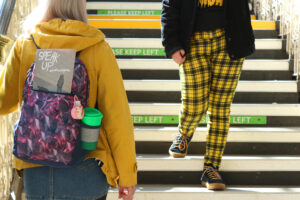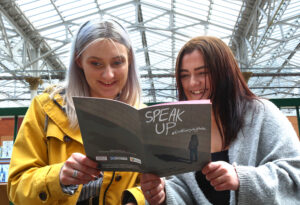Small Steps – Big Changes A Blog by Sarah Robinson Galloway, YouthLink Scotland


If you want to view paradise
Simply look around and view it
Anything you want to, do it
Want to change the world?
There’s nothing to it.
(Pure Imagination, Anthony Newley / Leslie Bricusse, soundtrack of Willy Wonka and the Chocolate Factory)
When I graduated from university our Chancellor told me to ‘go change the world’ which she probably also said to the hundreds of other students graduating that day. I took it as sentimentality at the time but now I have found myself in a job where I am trying to do just that.
I am passionate about making a difference and supporting young people and youth workers tackle prejudice and hate crime in Scotland. I fundamentally believe in what I am doing and I believe that I am doing the right thing.
But it can be hard to know when you are doing the right thing. In some situations we want to help but are afraid of doing the wrong thing or making the situation worse. On Saturday morning I was talking to young people about the new Action on Prejudice resource. Speak Up gives young people different options to become active bystanders. That night my friend and I spotted a vulnerable individual swaying their way across a busy road. It would have been hypocritical to have spent the morning encouraging young people to help and then not do it myself. In this instance we stayed in the car, drove slowly behind the individual as they walked on down the road and called the police.
I though, am an adult, who delivers training to youth workers and young people on being an active bystander. As a result I have a good idea of what I can do to help and how to keep myself safe. An active bystander is someone who steps in to help rather than just observe or ignore a situation. But how confident would a young person be to take on that role?
This is why having resources like Speak Up for young people is so vital. It takes young people and their youth workers through the 5 D’s of bystander intervention in relation to hate crime. The 5D’s are direct, distract, delegate, document and delay. It gives young people the tools they need to do something when they want to help but also keep themselves safe.
A natural instinct may be to directly intervene, to go between a perpetrator of hate crime and the victim. In rare cases this might be the best option, but we encourage young people to take a minute and consider is this safe to do? Can you still help if you end up targeted yourself?
Distracting is the next option. Ask the perpetrator the time to give a victim a minute to get away. In some instances again this may work, but like with direct is it always safe to do so?
Then we have delegating, the most popular with young people in schools It is about giving someone else the responsibility to do something. It can be intimidating for anyone to get involved in a hate incident but there are people who can deal with it better than you might be able to. The most obvious delegation would be to a teacher or youth worker, call the police. In the case of an assault maybe an ambulance.
A very popular action to take is to document an incident. While taking detailed notes of what is happening can be really helpful, there are difficulties with the more popular form of documenting. Filming is now a go to response in an age of social media but brings with it its own dangers. You can bring attention to yourself and therefore be targeted or if your phone has crucial evidence on it, it can be taken by police for an unknown length of time.
Finally, we have the option to delay. To wait until the incident is over and then check in with the victim. Ask the question ‘Are you okay?’ From talking to people who have experienced hate crimes regularly, this is the worst aspect of it. The aftermath when no one comes up and checks in. It can lead to a feeling that nobody cares and most of the time no one comes up because they don’t know they can.
Checking in with someone afterwards can make it clear that they are not alone. It can help someone to report if you offer to give a statement. You can also just wait with them until their parent or someone else comes to get them.
These are basic steps we can all take to help in these situations. They are the tools young people can use to be able to confidently help. We have it in our power to change the world for the better, we all do. All we need to do is make someone feel they are not alone and we have changed one person’s world and if we do it again that’s another world changed. It is small steps, but together they build a picture that show a society that can come together to say hate has no home here.
What we need to do now is to connect, unite and work together to ensure the society we create for future generations is what we all want and need; equal, tolerant and diverse. I am in a privileged position to be able to see and support the work that so many different organisations are doing. As Willy Wonka said, “if we want to change the world, there’s nothing to it” especially if we all come together and be there when someone else needs a helping hand.
